Coordination of sonic hedgehog and Wnt signaling determines ventral and dorsal telencephalic neuron types from human embryonic stem cells
- PMID: 19906872
- PMCID: PMC2778748
- DOI: 10.1242/dev.036624
Coordination of sonic hedgehog and Wnt signaling determines ventral and dorsal telencephalic neuron types from human embryonic stem cells
Abstract
The directed differentiation of forebrain neuronal types from human embryonic stem cells (hESCs) has not been achieved. Here, we show that hESCs differentiate to telencephalic progenitors with a predominantly dorsal identity in a chemically defined medium without known morphogens. This is attributed to endogenous Wnt signaling, which upregulates the truncated form of GLI3, a repressor of sonic hedgehog (SHH). A high concentration of SHH, or the inhibition of Wnt by dickkopf 1 (DKK1) together with a low concentration of SHH, almost completely converts the primitive dorsal precursors to ventral progenitors, which is partially achieved through both downregulation of the truncated GLI3 and upregulation of full-length GLI3 expression. These dorsal and ventral telencephalic progenitors differentiate to functional glutamatergic and GABAergic neurons, respectively. Thus, although hESCs generate dorsal telencephalic cells, as opposed to ventral progenitors in other vertebrates, in the absence of exogenous morphogens, human cells use a similar molecular mechanism to control the dorsal versus ventral fate. The coordination of Wnt and SHH signaling through GLI3 represents a novel mechanism that regulates ventral-dorsal patterning in the development of forebrain neuronal subtypes.
Figures
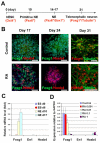
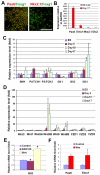
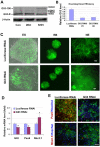
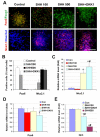
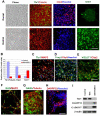

Similar articles
-
Subregional specification of embryonic stem cell-derived ventral telencephalic tissues by timed and combinatory treatment with extrinsic signals.J Neurosci. 2011 Feb 2;31(5):1919-33. doi: 10.1523/JNEUROSCI.5128-10.2011. J Neurosci. 2011. PMID: 21289201 Free PMC article.
-
Patterning the dorsal telencephalon: a role for sonic hedgehog?J Neurosci. 2007 Oct 24;27(43):11595-603. doi: 10.1523/JNEUROSCI.3204-07.2007. J Neurosci. 2007. PMID: 17959802 Free PMC article.
-
Ectopic sonic hedgehog signaling impairs telencephalic dorsal midline development: implication for human holoprosencephaly.Hum Mol Genet. 2007 Jun 15;16(12):1454-68. doi: 10.1093/hmg/ddm096. Epub 2007 Apr 27. Hum Mol Genet. 2007. PMID: 17468181
-
New perspectives on the mechanisms establishing the dorsal-ventral axis of the spinal cord.Curr Top Dev Biol. 2019;132:417-450. doi: 10.1016/bs.ctdb.2018.12.010. Epub 2018 Dec 26. Curr Top Dev Biol. 2019. PMID: 30797516 Free PMC article. Review.
-
Sonic hedgehog functions through dynamic changes in temporal competence in the developing forebrain.Curr Opin Genet Dev. 2010 Aug;20(4):391-9. doi: 10.1016/j.gde.2010.04.008. Epub 2010 May 11. Curr Opin Genet Dev. 2010. PMID: 20466536 Free PMC article. Review.
Cited by
-
Functional maturation of hPSC-derived forebrain interneurons requires an extended timeline and mimics human neural development.Cell Stem Cell. 2013 May 2;12(5):573-86. doi: 10.1016/j.stem.2013.04.005. Cell Stem Cell. 2013. PMID: 23642366 Free PMC article.
-
Induced Pluripotent Stem Cells in Huntington's Disease Research: Progress and Opportunity.J Huntingtons Dis. 2016 Jun 28;5(2):99-131. doi: 10.3233/JHD-160199. J Huntingtons Dis. 2016. PMID: 27372054 Free PMC article. Review.
-
Cortical interneurons from human pluripotent stem cells: prospects for neurological and psychiatric disease.Front Cell Neurosci. 2013 Mar 13;7:10. doi: 10.3389/fncel.2013.00010. eCollection 2013. Front Cell Neurosci. 2013. PMID: 23493959 Free PMC article.
-
Endogenous WNT signaling regulates hPSC-derived neural progenitor cell heterogeneity and specifies their regional identity.Stem Cell Reports. 2014 Dec 9;3(6):1015-28. doi: 10.1016/j.stemcr.2014.10.004. Epub 2014 Nov 13. Stem Cell Reports. 2014. PMID: 25458891 Free PMC article.
-
Stem Cell Models and Gene Targeting for Human Motor Neuron Diseases.Pharmaceuticals (Basel). 2021 Jun 12;14(6):565. doi: 10.3390/ph14060565. Pharmaceuticals (Basel). 2021. PMID: 34204831 Free PMC article. Review.
References
-
- Ahn S., Joyner A. L. (2004). Dynamic changes in the response of cells to positive hedgehog signaling during mouse limb patterning. Cell 118, 505-516 - PubMed
-
- Alvarez-Medina R., Cayuso J., Okubo T., Takada S., Marti E. (2008). Wnt canonical pathway restricts graded Shh/Gli patterning activity through the regulation of Gli3 expression. Development 135, 237-247 - PubMed
-
- Anderson K. D., Reiner A. (1991). Immunohistochemical localization of DARPP-32 in striatal projection neurons and striatal interneurons: implications for the localization of D1-like dopamine receptors on different types of striatal neurons. Brain Res. 568, 235-243 - PubMed
-
- Arlotta P., Molyneaux B. J., Chen J., Inoue J., Kominami R., Macklis J. D. (2005). Neuronal subtype-specific genes that control corticospinal motor neuron development in vivo. Neuron 45, 207-221 - PubMed
-
- Bai C. B., Stephen D., Joyner A. L. (2004). All mouse ventral spinal cord patterning by hedgehog is Gli dependent and involves an activator function of Gli3. Dev. Cell 6, 103-115 - PubMed
Publication types
MeSH terms
Substances
Grants and funding
LinkOut - more resources
Full Text Sources
Other Literature Sources
Molecular Biology Databases

